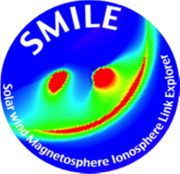Engineering:Solar wind Magnetosphere Ionosphere Link Explorer
| Names | SMILE |
|---|---|
| Operator | ESA · CAS |
| Website | www |
| Start of mission | |
| Launch date | 2021 |
| Rocket | European Launch Vehicle |
| Orbital parameters | |
| Reference system | Geocentric |
| Regime | Molniya orbit |
| Perigee altitude | ~ 12,742 km |
| Apogee altitude | ~ 127,420 km |
| Inclination | 63.4° |
 Official insignia for the SMILE mission Cosmic Vision | |
Solar wind Magnetosphere Ionosphere Link Explorer (SMILE) is a planned joint venture mission between the European Space Agency and the Chinese Academy of Sciences to study the interaction between Earth's magnetosphere and the solar wind, while simultaneously monitoring the magnetosphere's plasma environment.[1][2] Launch is expected at the end of 2021.[3]
Overview
SMILE will be equipped to simultaneously capture images and movies of the magnetopause, polar cusps, and aurora.[1] Traditionally, satellites have taken local measurements of different regions to build up a global picture of the magnetosphere. However, a recent discovery that the magnetosphere emits X-rays will allow SMILE to capture more comprehensive data than previous missions did through the analysis of these X-rays.[3]
Key instruments on board the spacecraft will include:[3][4]
- Soft X-ray Imager (SXI) – used to study the interaction of the solar wind with Earth's magnetosphere. Telescope will be developed by scientists from the University of Leicester.[5]
- UV Imager (UVI) – used to observe and measure the aurora borealis along with identifying polar cap boundaries. Telescope will use a four-mirror design along with new filters.
- Light Ion Analyser (LIA) – on site measurement of ions in the solar wind.
- Magnetometer (MAG) – on site measurement of magnetic fields.
The mission consists of a propulsion module and service module provided by the CAS, and a payload module containing all of the scientific instruments and an X-band communications system by the ESA. The launch will be conducted by ESA, while the Mission Operations Centre will be run by CAS; both organizations will jointly operate the Science Operations Centre.[2]
The spacecraft is currently planned for launch in 2021 to a Molniya orbit with an apogee of 20 R⊕ (Earth radii, where 1 R⊕ = 6,371 km) using a European Launch Vehicle. Mission cost is estimated to be €92 million.[4]
History
Following the success of the Double Star mission, the ESA and CAS decided to jointly select, design, implement, and launch a space mission together for the first time. After initial workshops, a call for proposals was announced in January 2015. After a joint peer review of mission proposals, SMILE was selected as the top candidate out of 16 proposed.[1] The SMILE mission proposal was jointly led by the University College London and the Chinese National Space Science Center. From June to November 2015, the mission entered initial studies for concept readiness, and final approval was given for the mission by the ESA Science Programme Committee in November 2015.[3][2]
A Request For Information (RFI) on provisions for the payload module was announced on 18 December 2015. The objective was to collect information from potential providers to assess low risk payload module requirements given stated interest in the mission, in preparation for the Invitation to Tender in 2016.[2]
References
- ↑ 1.0 1.1 1.2 "ESA and Chinese Academy of Sciences to study Smile as joint mission". ESA. 22 June 2015. http://www.esa.int/Our_Activities/Space_Science/ESA_and_Chinese_Academy_of_Sciences_to_study_Smile_as_joint_mission. Retrieved October 2015.
- ↑ 2.0 2.1 2.2 2.3 "Request for Information (RFI) for the provision of the payload module for the joint ESA-China SMILE mission". ESA. 18 December 2015. http://sci.esa.int/cosmic-vision/57064-request-for-information-rfi-for-the-provision-of-the-payload-module-for-the-joint-esa-china-smile-mission/. Retrieved 8 January 2016.
- ↑ 3.0 3.1 3.2 3.3 Dunning, Hayley (4 June 2015). "Solar wind monitoring mission passes the first hurdle". Imperial College London. http://www3.imperial.ac.uk/newsandeventspggrp/imperialcollege/newssummary/news_4-6-2015-12-39-12. Retrieved 4 June 2015.
- ↑ 4.0 4.1 Branduardi-Raymon, Graziella; Wang, Chi. "Joint Scientific Space Mission Chinese Academy of Science (CAS) - European Space Agency (ESA) PROPOSAL SMILE: Solar wind Magnetosphere Ionosphere Link Explorer" (PDF). http://www.mssl.ucl.ac.uk/~gbr/SMILE/images/SMILE_Executive_Summary.pdf. Retrieved 4 June 2015.
- ↑ "Leicester space scientists develop space satellite which predicts solar storms". Leicester Mercury. 4 June 2015. http://www.leicestermercury.co.uk/Leicester-space-scientists-develop-space/story-26636671-detail/story.html. Retrieved 4 June 2015.

